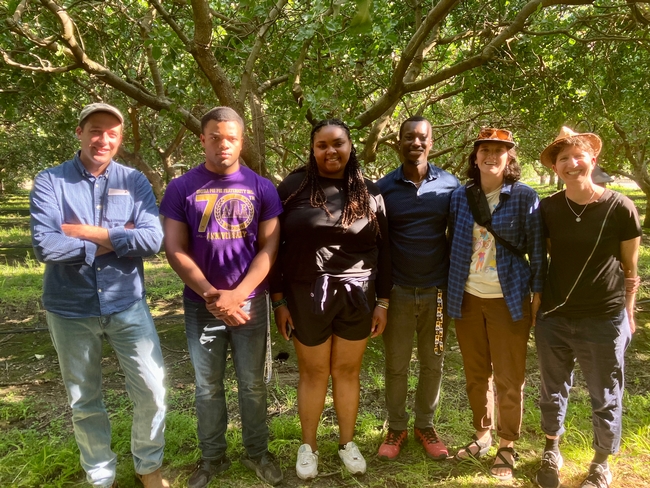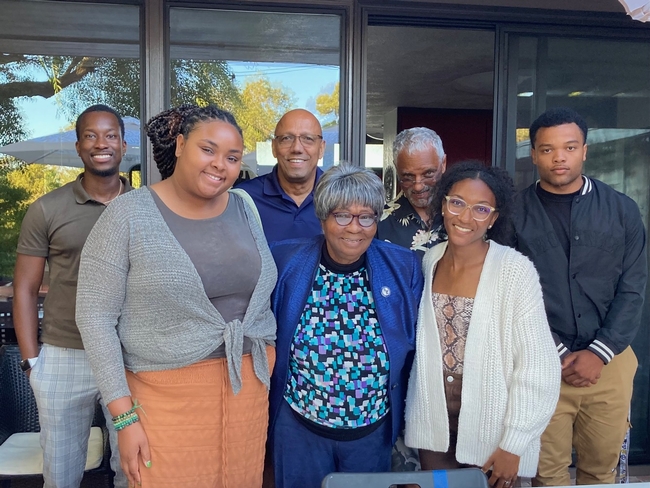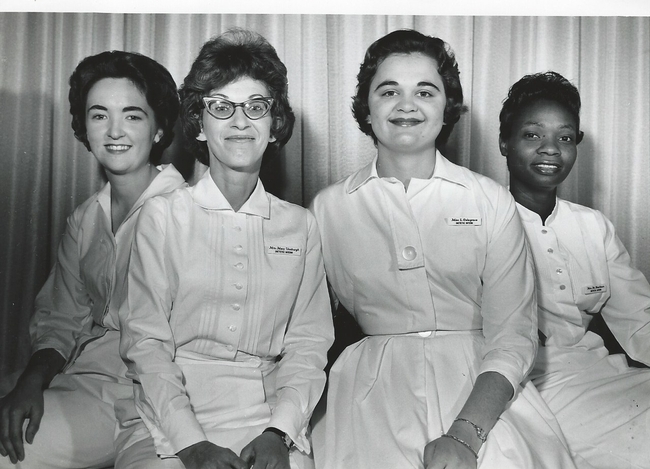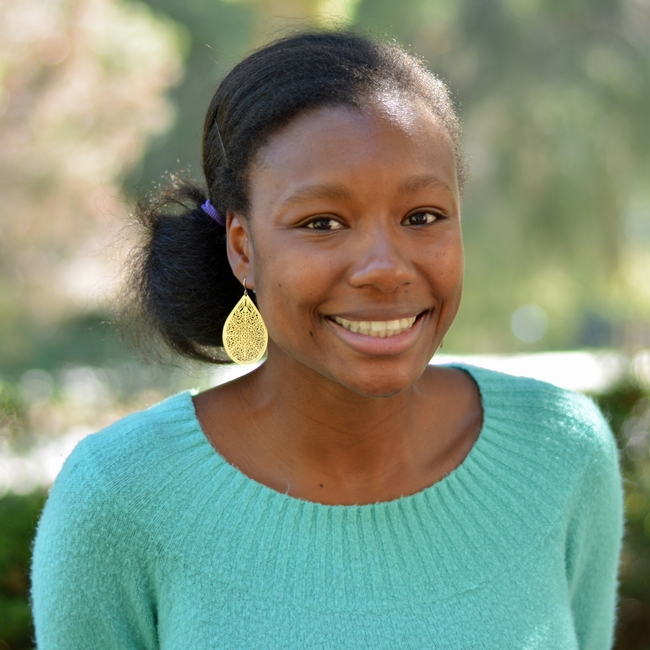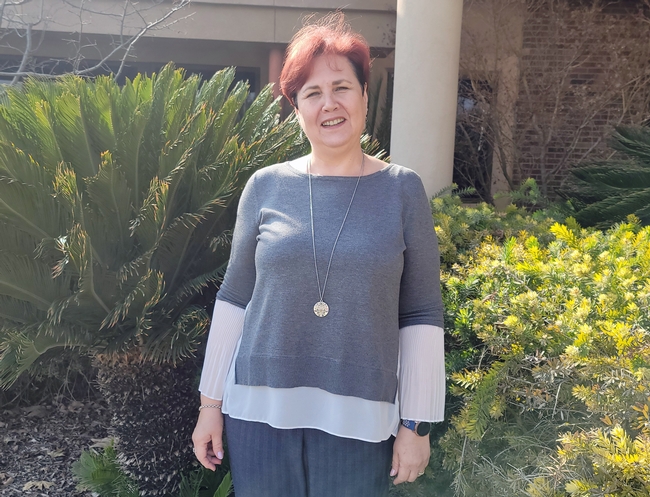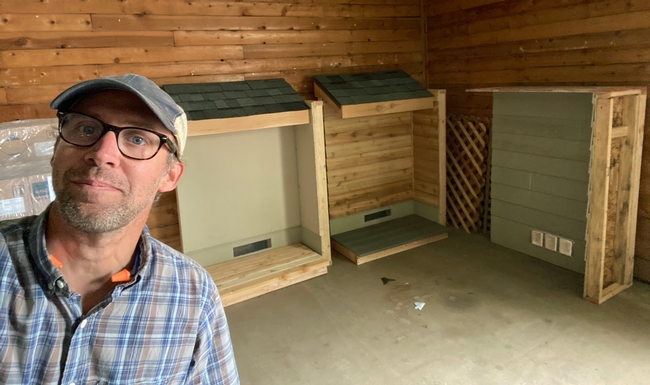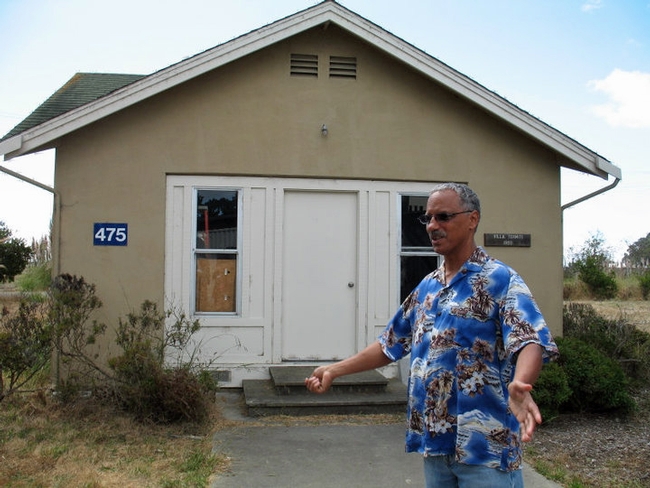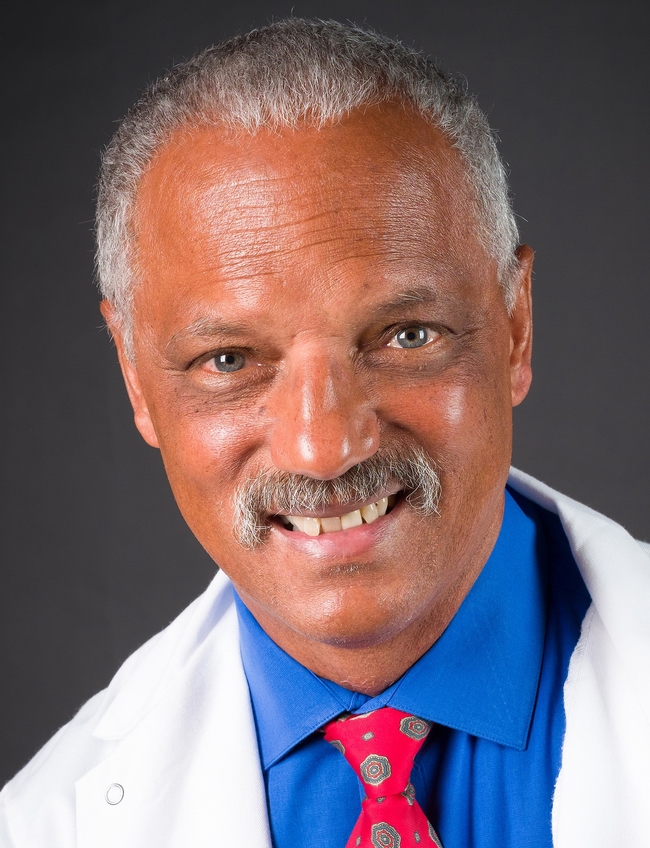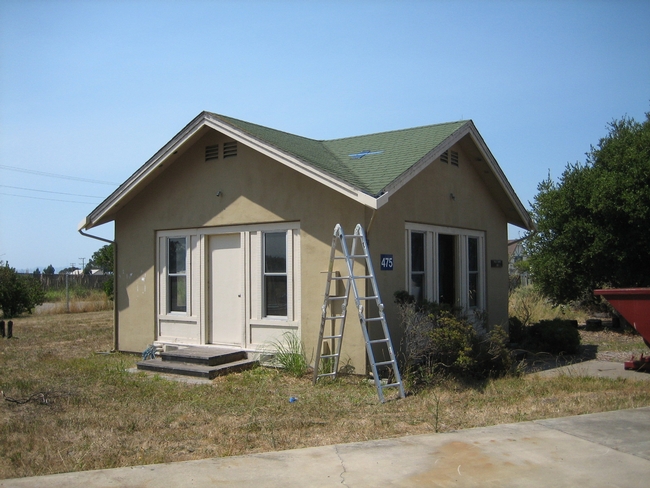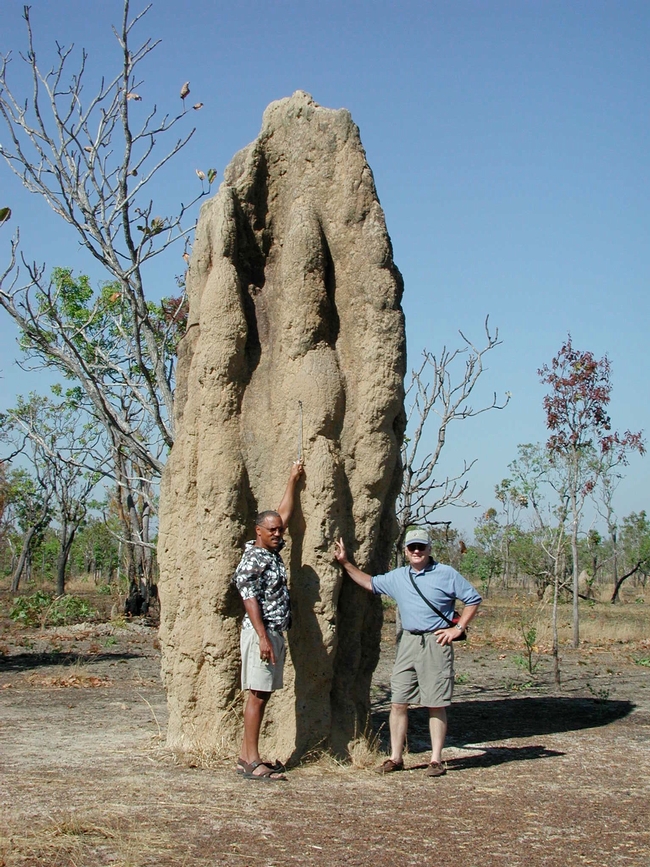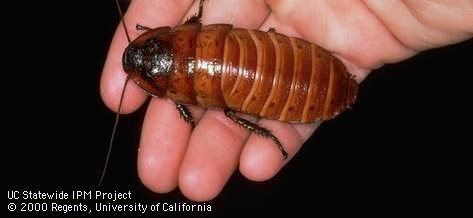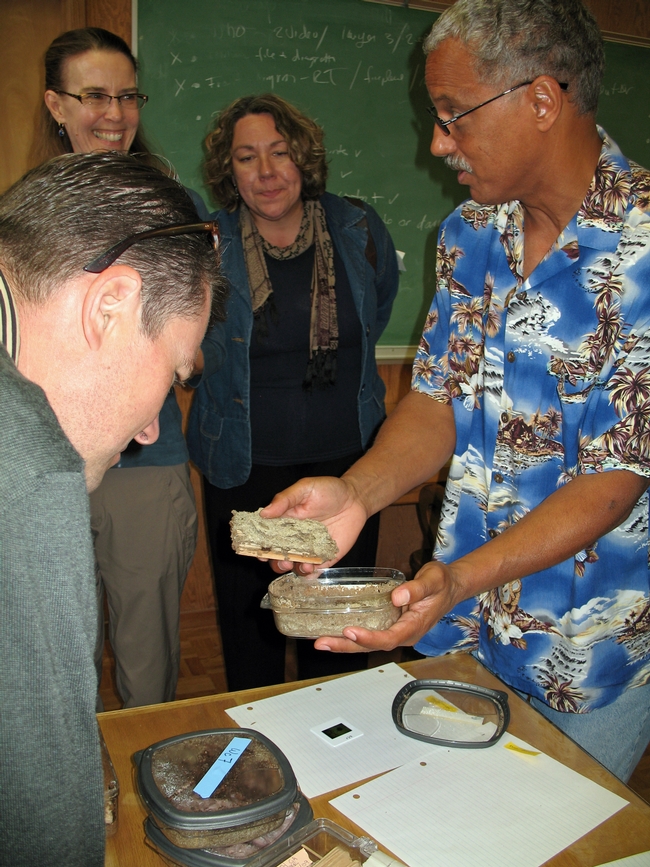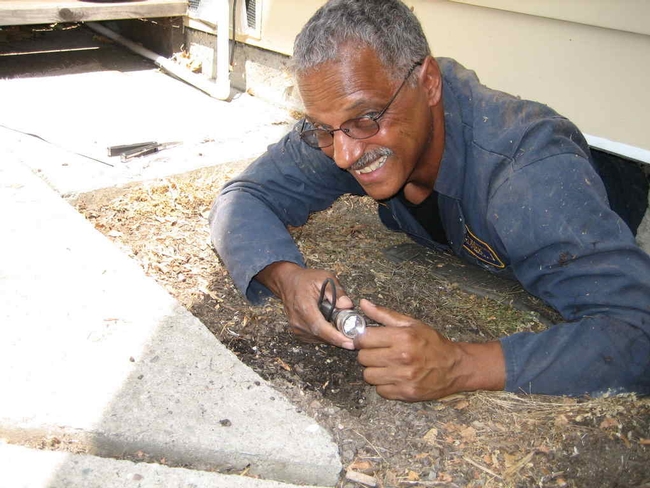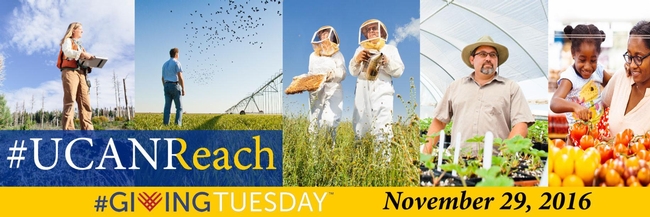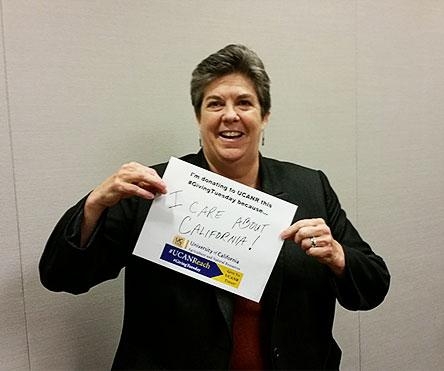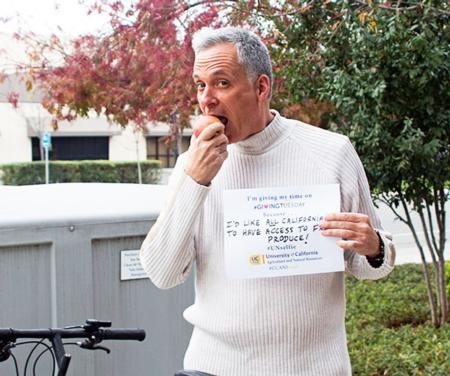Posts Tagged: Vernard Lewis
‘It’s okay to be different,’ Lewis advises Black environmental scholars
Undergraduates from Historically Black Colleges and Universities visit UC for summer session
Na'Zyia Dowdy-Arnold and Destinee S. Whitaker, both of Spelman College, Christopher Bass of Morehouse College, and Carlos Jackson of Tuskegee University spent the summer getting research experience with UC Berkeley scientists. The four undergraduates from Historically Black Colleges and Universities were participating in the UC Berkeley Department of Environmental Science, Policy and Management HBCU Environmental Scholars Program.
“The program aims to facilitate two-way learning while fostering preparedness and belonging for HBCU students interested in graduate school at UC Berkeley,” said co-founder Rosalie Zdzienicka Fanshel, UC Berkeley doctoral candidate.
Now in its second year, the program, was co-founded by UC Berkeley professor Tim Bowles who also co-directs the program with Fanshel in cooperation with Tuskegee University and Spelman College faculty members.
“After two years as a mentor in the ESPM/UCB HBCU summer research immersion program, I was thrilled to witness the transformation of students,” said Vernard Lewis, emeritus UC Cooperative Extension entomology specialist. “This transformation included doing high-level science and increasing the feeling of belonging. The current cohort of four HBCU students have immersed themselves in lab and field sciences that include campus and ANR units. The hope is to expand the program and to increase the talent pool of HBCU students for graduate programs and careers at UC and ANR.”
During their two-month program, the students toured the San Joaquin Valley with Fanshel and Kristin Dobbin, UCCE water justice policy and planning specialist at UC Berkeley. They visited Allensworth, a utopian agricultural community focused on self-reliance in Tulare County founded in 1908 by African Americans, and UC Kearney Agricultural Research and Extension Center in Parlier, where they met Houston Wilson, UCCE entomology specialist.
Near the end of their stay, Lewis and his wife, Lisa Kala, who held administrative, research and teaching positions in UC Berkeley's Graduate School of Education for over 40 years, hosted a backyard barbecue at their Hayward home for the students to meet Black UC faculty, administrators and alumni.
Lewis assembled African American friends Mary Blackburn, Gloria Burkhalter, Bill Stevens, Bilal Shabazz and his daughter Amani, Fred Logan, Ben Tucker, Elize Brown, Gregory Bradley, Vincent Duncan, Maria Shalita, Carol Chambers-Blockton, Jariel Arvin, Frank McPherson and Charles Clary – some retired and others still enjoying long careers – to meet the young scholars on July 24. Harry LeGrande, emeritus UC Berkeley vice chancellor of student affairs who served in higher education for 45 years, joined the group by Zoom.
McPherson, who retired from UC ANR as UCCE director for the Bay Area in February, cooked up hot links, seafood gumbo and black-eyed peas, served with salad and fresh fruit for the occasion.
“It's okay to be different,” Lewis, the first Black entomologist hired at UC Berkeley, told the students. “You're not alone. We're all with you,” he added, gesturing to the older guests, who had described their professional journeys and how they navigated sometimes unfriendly environments. Some had graduated from college amid the civil rights movement of the 1960s.
Blackburn recalled being offered one of four coveted spots in UC Berkeley's new Master of Public Health Nutrition – Dietetic Internship program after graduating from Tuskegee University in 1963. It didn't seem feasible to move since her husband owned his business in Atlanta and they had four young children. But when the Tuskegee University president said she had to go, Blackburn understood that opportunity was not just about her and three days later she boarded a plane to California. In 1968, Blackburn became one of the first Registered Dietitians in the U.S. and completed her Ph.D. in human nutrition and health planning and administration at UC Berkeley in 1974.
“Find your allies; find your advocates,” Blackburn, UC Cooperative Extension's community nutrition and health advisor for Alameda County for the past 33 years, advised the students.
After the barbecue, the students began collecting email addresses and making connections with their new allies on LinkedIn.
“During our feedback sessions with the students, they expressed their appreciation to all those in attendance, especially Vernard Lewis, who orchestrated the event,” said McPherson. “One of the most important takeaways from the event was their desire to have this type of event with accomplished Black administrators and professionals continue to be part of the programming while at Berkeley.
“They also suggest that these events take place earlier, so that they might take advantage of the knowledge and experience these Black professionals bring to the table, not only as they return to their individual institutions and career paths, but also have access to this network while in the Bay Area.”
A week earlier, during a lunch with Blackburn and Lewis, the students had said they appreciated meeting the two accomplished Black scientists and wished they could meet more. That comment spurred Lewis and Blackburn to organize the barbecue. Despite the short notice, several of their Black colleagues attended. “They showed up because they care,” Lewis said.
They will continue to modify the program based on feedback from the students.
The first year of the program was funded by UC Berkeley's Berkeley Food Institute and Spelman College. The second year was funded by the UC Berkeley Office of Graduate Diversity; Department of Environmental Science, Policy, and Management; and donations from other campus programs and individuals. Each student receives a $5,000 stipend, room and board and travel.
Bowles and Fanshel have applied for a UC-HBCU initiative grant from UC Office of the President to continue the program for another three years.
Names in the News
Richards named ag land acquisitions academic coordinator
Chandra Mercedes Richards joined UC Cooperative Extension as agricultural land acquisitions academic coordinator II for San Diego, San Bernardino and Riverside counties on May 10.
As an agricultural lands acquisition academic coordinator II, Richards aims to better support San Bernardino, Riverside, and San Diego counties through the Sustainable Agricultural Lands Conservation (SALC) grant program.
“More specifically, I will be identifying and addressing regional barriers to land use planning, connecting producers with ANR services and climate-smart technical assistance providers, supporting grant applications and agricultural assessments, and ultimately protecting agricultural systems in perpetuity,” she said.
The East Coast native has lived in California for 11 years and is rooted in San Diego. Prior to joining UC ANR, Richards was a conservation ecologist at the greater San Diego Resource Conservation District, where she led the agriculture, forest health, and habitat restoration programs and supported climate-smart agriculture through planning, education, and technical assistance. She also was a key grant writer and project implementation leader.
She earned a Ph.D. in soil biogeochemistry from UC Berkeley and double B.S. degrees in chemistry and mathematics from Pennsylvania State University.
Richards is based in San Diego and can be reached at cmrichards@ucanr.edu.
Bayless named Master Gardener Program coordinator
Aliya Bayless has been named the UC Master Gardener Program coordinator for Tulare and Kings counties. She joined the UC Master Gardener Program in 2016 when she decided to start her own garden and, in her words, “didn't know anything about gardening.”
Bayless is originally from Baku, the capital city of Azerbaijan, located along the Caspian Sea, but has been a resident of Visalia since 2006. Although she grew up in the city, she learned to love plants (mostly house plants) from family members including her grandmother, father and aunt. When she was an adult, her dad finally bought a piece of land that he had dreamt of for many years. It was on this new property that he started his own garden with a lot of fruit trees and berries. Bayless helped him as much as she could, but like many gardeners, her main job was pulling weeds.
“Since then, I've learned a lot about gardening, met amazing people and enjoyed every minute of volunteering. I'm very excited to start my new journey as a program coordinator and hope that I will be able to help with the program and future projects,” she said.
Bayless is based in Tulare and can be reached at ambayless@ucanr.edu. – By Melissa Womack
Lewis selected to deliver ESA Founders' Memorial Lecture
Vernard Lewis, emeritus UC Cooperative Extension specialist at UC Berkeley, has been selected to deliver the Founders' Memorial Lecture at the 2021 annual meeting of the Entomological Society of America, set Oct. 31-Nov. 3 at the Colorado Convention Center in Denver.
Lewis is a national and international authority on drywood termites and is known for his pioneering research on detection innovations and nonchemical methods of control. A nationally recognized urban entomologist, Lewis's research encompasses a variety of urban pests including ants, bed bugs, cockroaches and wood-boring beetles. He has authored and co-authored more than 150 refereed and trade magazine articles and book chapters on termites and household insect pests.
The Founders' Memorial Award was established in 1958 to honor the memory of scientists who made outstanding contributions to entomology. On Nov. 2, Lewis will give a presentation on the life and legacy of African-American entomologist and civil rights advocate Margaret Collins.
To read more about Lewis' career, see https://ucanr.edu/blogs/blogcore/postdetail.cfm?postnum=24625 and to learn more about Margaret Collins see Bug Squad https://ucanr.edu/blogs/blogcore/postdetail.cfm?postnum=47649.
Tompkins recognized for fire safety
The Plumas County Fire Safe Council announced Ryan Tompkins, UC Cooperative Extension forestry and natural resource advisor, as one of two new recipients in its Fire Safe Recognition Program on May 13.
Mike Flanigan of Flanigan-Leavitt Insurance nominated Tompkins for the award for playing a significant role in improving the community's fire safety and emergency preparedness.
“Ryan Tompkins has been a huge part of the progress made with the Quincy Firewise USA initiative,” Flanigan said in his nomination letter. “He is currently the UC Cooperative Extension Forester for Plumas, Sierra, and Lassen counties where his research focuses on forest restoration and post-fire restoration. He successfully received certification in his own neighborhood – Galleppi Ranch. He is thorough and keeps the committee focused. We on the Quincy Firewise Committee are very grateful for Ryan's professional input and support.”
Tompkins started his own firewise community four years ago. “Just my little neighborhood HOA of 36 residences,” Tompkins said, “but when I joined UC ANR, I really felt that I needed to focus on making the entire town of Quincy (over 2,000 residences) a Firewise USA Site to serve all the facets of our community and we did it this May!”
“Also, last December, we helped the Sierra Brooks community outside of Loyalton become the first NFPA Firewise USA Site in Sierra County! I'm now working with Sierra City (another community in Sierra County) on their assessment. I see value in the NFPA Firewise USA site program because it focuses on empowering residents to educate, outreach, and work together as a community in wildfire preparedness. It certainly isn't a panacea, but it's a start and a good way to engage folks.”
South Coast REC honored as community service partner
Since October 2019, the Saddleback Valley Adult Transition Program and the South Coast Research and Extension Center have been developing a vocational training program for adult transition program students. As a result of this partnership, South Coast REC was recognized as Community Service Partner of the Year.
Starting on April 16, students began assisting with propagating vegetables in the South Coast REC greenhouse, harvesting, postharvest processing, maintaining vegetable crops, pruning, irrigating, and detecting and identifying insects. This unique partnership allows students to learn skills that can be applied in various settings vocationally, at home and on campus. UC Master Gardener volunteers helped them develop a more robust school garden.
“As the community starts to reopen, we look for further integration of the fruits and vegetables produced within our micro businesses for all students,” wrote Principal Raymund Bueche. “This includes the processing of produce and vegetables in the Educafe and Esperanza kitchens for student consumption and the addition of fresh items including smoothies and juices in Hope Café, a student-run coffee cart, and The Cutie Pie Café, a student-run restaurant.”
This project has also been embraced by Orange County Local Partnership Agreement, a group spearheaded by Chapman University to bring together organizations serving special needs and at-risk youth with training and on-the-job experiences as they transition from school to the workforce.
Vernard Lewis, UC Berkeley’s first African American entomologist, retires from 35-year career terminating termites, bed bugs and cockroaches
Lewis has published about 150 papers and delivered more than 700 presentations on termites, bed bugs and cockroaches, but considers building a house for termites a career feat.
In the early 1990s, the UC Cooperative Extension specialist needed a place to test drywood termite detection and control methods. The College of Natural Resources wasn't keen on infesting a building with destructive pests near UC Berkeley's historic buildings, but ultimately allowed Lewis to construct the Villa Termiti in Richmond, about six miles north of campus.
“Babysitting my brothers and sisters sure helped develop my negotiating skills,” said Lewis, the oldest of 10 children.
Built at the UC Richmond Field Station in 1993, the 400-square-foot, wooden structure has been fumigated, x-rayed and featured on the cover of Popular Mechanics. It nearly burned when six test boards were scorched by a microwave device that was supposed to kill termites; Lewis observed termites living in the wood despite the microwaves and fire. Fortunately, the damage was minor.
Villa Termiti has since hosted ants, subterranean termites, wood-boring beetles and bed bugs for subsequent research projects.
The Minnesota native's interest in insects was piqued as a kindergartner, after Lewis moved from Minnesota to live with his grandparents in Fresno for six years. “California has a lot more bugs because Minnesota is frozen six months out of the year,” he said wryly. “During recess, while other kids were kicking balls, I was catching grasshoppers and feeding them to harvester ants.”
For many years, pest control operators relied on fumigation. As claims were made without scientific basis that microwave, freezing, heating, electricity, orange oil and modified fumigation were effective, Lewis tested the methods.
“If it didn't work in a lab set-up, it's not going to work where conditions are more complex in homes and buildings,” said Haverty, who published a paper with Lewis in 1996 comparing six techniques. “Nothing was as effective as fumigation.”
Lewis showed how best to do spot treatments for termites rather than tenting a whole house for fumigation, which can be expensive for homeowners.
University of Georgia entomology professor Brian Forschler said Lewis is trusted for his integrity.
“Urban entomology programs across the country are essentially funded by donations from industry so you have to walk a tightrope in that funding scenario,” Forschler explained. “You don't want to fall prey to telling your sugar daddy what they want to hear. Vernard is clearly not in that league, he has garnered respect and remained an objective scientist.”
Lewis has found mentoring young scientists at UC Berkeley and stimulating children's interest in science rewarding. In 2000, he joined the City Bugs project with Oakland Unified School District, educating K-12 school teachers and students about insects, life sciences and biodiversity.
“I like to bring live props and get people involved,” Lewis said.
In 1993, for a presentation in front of 300 students at Claremont Middle School in Oakland, Lewis brought a Madagascar cockroach, which measured two to three inches long.
“A kid in the second row asked to see what was in the box. He asked to hold it so I put the cockroach in his hand and he dropped it on the floor. As the cockroach ran around, kids are flying out the door. We're trying to catch it and calm the kids down, calling ‘Come back.' It was wild,” Lewis said, adding, “The Madagascar cockroach is big, but it won't hurt anybody.”
“It's been fun,” said Lewis about his career, but he is quick to point out his academic success wasn't served up with a silver spoon. “I had no spoon,” he said, jokingly.
“My high school counselor said I wasn't bright enough to go to college. I took offense to that,” said Lewis, recalling that he had scored well on the IQ tests that were administered liberally in schools in the 1950s and 1960s. “I asked him what was the best university in the country. He said, ‘UC Berkeley,' so I decided to go there.”
In 1979, Lewis earned an M.S. in entomology at UC Berkeley and started his own pest management business, IPM Systems, Inc., in 1982. Prison trustees affectionately dubbed him “Killer” when he exterminated bed bugs and cockroaches as San Quentin State Prison's vector control coordinator from 1986 through 1988. He earned his Ph.D. in entomology at UC Berkeley in 1989 and continued his entomological research on campus as a postdoctoral fellow.
In 1991, Lewis was hired as a UC Cooperative Extension specialist in entomology in the Department of Environmental Science, Policy and Management (ESPM) at UC Berkeley.
An advocate for diversity, Lewis is one of 20 entomologists featured in the book “Memoirs of Black Entomologists,” published by the Entomological Society of America in 2015 to encourage black students to pursue careers in the life sciences and providing practical advice on how to become successful in science. Of ESA's 7,000 members, only about 100 are African or African American.
Lewis's research and extension has been honored by several institutions and organizations, including his induction into the Pest Management Professionals' Hall of Fame in 2016, an Urban Entomology award from the Pacific Branch of the Entomological Society of America in 2002 and the Orkin Outstanding Research Award in 1998. The Florida Entomological Society recognized his efforts to promote diversity in the field of entomology by presenting him with its Pioneer Lecture Award in 2015. Lewis delivered a lecture on Margaret James Strickland Collins, the first African American woman entomology professor, whom he knew and admired.
While Lewis's work has focused on California, his career has also taken him out of the country. Lewis was a visiting professor at Kyoto University in Japan in 2011. In 2000, the United Nations selected him as the leader and founding member of its Global Termite Expert Group. He chaired the 20-member group, which worked together on projects from 2000 to 2008. Internationally, mosquitoes are the No. 1 pest and termites are No. 2.
“We couldn't stop the use of DDT on mosquitoes, but we can stop its use on termites,” Lewis said. The UN group presented lower-risk alternatives for termite management and negotiated with pest control professionals in different countries to change their practices. “That was one of the most rewarding projects,” he said, noting that China significantly reduced its use of the insecticide.
In retirement, Lewis looks forward to taking a few months to “clear my mind,” before considering offers from private companies and international contacts. While his wife, Lisa Kala, continues her work in the School of Education at UC Berkeley, Lewis intends to spend more time with their daughter, Aikane, and young grandson, Tahir. He has been granted emeritus status and will continue leading efforts to promote diversity and equity for the College of Natural Resources.
UC ANR recruits for final round of UCCE positions approved in 2014
UC ANR is in its sixth and final round of hiring for Cooperative Extension advisor and specialist positions released in December 2014. The 43 positions were released for recruitment in phases over time to enable Human Resources to accomplish the search and hiring process in an orderly fashion and to allow leadership to evaluate ANR's resources on a real-time basis, deal with unexpected changes in staffing and address unanticipated issues as they arise.
Round 6 (Fall 2016)
- Area Desert Livestock Advisor (Imperial, Riverside, San Bernardino)
- Area Forestry & Natural Resources Advisor (Sutter-Yuba, Butte, Nevada)
- Area Livestock & Range Advisor (Ventura, Santa Barbara)
- Area Dairy Systems Advisor (Sonoma, Marin, Mendocino)
- Biometeorology Specialist (College of Agricultural and Environmental Science, UC Davis)
For the 2016 call for UCCE positions, Program Council has reviewed the 138 positions proposed and forwarded its recommendations to VP Glenda Humiston, who will announce in December the future rounds of hiring. The approved positions will be announced in ANR Update.
To see the 2016 Call for Positions and the review process, visit http://ucanr.edu/sites/anrstaff/Divisionwide_Planning/2016_Call_for_Position.
UCANR raises funds and visibility on #GivingTuesday
On Nov. 29, ANR is participating in #GivingTuesday, a global day of giving fueled by the power of our social network. Celebrated on the Tuesday after Thanksgiving, #GivingTuesday kicks off the charitable season.
“We hope you will take advantage of this opportunity to raise some funds for our ANR programs while raising the visibility of the ways Californians benefit from your work,” said VP Glenda Humiston.
It's as simple as a tweeting a photo with “What are you thankful for? Take part in #GivingTuesday today to give back to your community! #UCANReach @ucanr http://ucanr.edu/sites/GivingTuesday.”
You don't use social media? No problem, email your friends. They probably wonder what you do for work. Tell them what your role is in this magnificent organization that's making life better for Californians and invite them to support our efforts by donating, sharing our message or volunteering.
A website has been created with links to all of ANR's programs, Research and Extension Centers and extension offices: http://ucanr.edu/sites/givingtuesday. It invites donors to designate the program or location to which they wish to donate.
The website also contains a toolkit for county offices and programs to participate. It includes:
- A customizable letter to send to stakeholders
- Templates for “unselfies.” Donors may take photos of themselves holding an unselfie sign and share on social media how they are giving.
- Sample tweets and social media posts
- Sample thank you note
“#GivingTuesday is a wonderful opportunity to gain support, donations, increase awareness and generate a buzz about UC ANR and all of our programs,” said Missy Gable, UC Master Gardener Program director.
“We are excited to be participating in the movement this year and hopeful that the results will be even better than the success we saw in 2015,” she said. “UC Master Gardener volunteers are passionate about how we serve our communities and the incredible impacts we are making. #GivingTuesday is a great opportunity to highlight the impacts we are making, build relationships and thank those who have supported us along the way.”
The UC Master Gardener #GivingTuesday website is at http://mg.ucanr.edu/Support/GivingTuesday.
4-H also has its own website http://4h.ucanr.edu/GivingTuesday. Last year, 4-H programs in 17 counties participated.
“Our goal for 4-H was to raise $10,000 and we exceeded our goal with donations totaling over $13,000,” said Andrea Ambrose, acting director of Development Services. “UCCE Placer County collected the largest amount for the 4-H Youth Development Program. We'll see which county collects the most this year.”
Although not as widely recognized as the shopping events Black Friday and Cyber Monday, #GivingTuesday appeals to people swept up in the spirit of giving at the end of the year.
“By joining the #GivingTuesday campaign, people involved in all ANR programs will have an opportunity to supplement their funding with private donations and have some fun,” said Ambrose.

